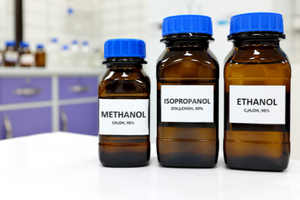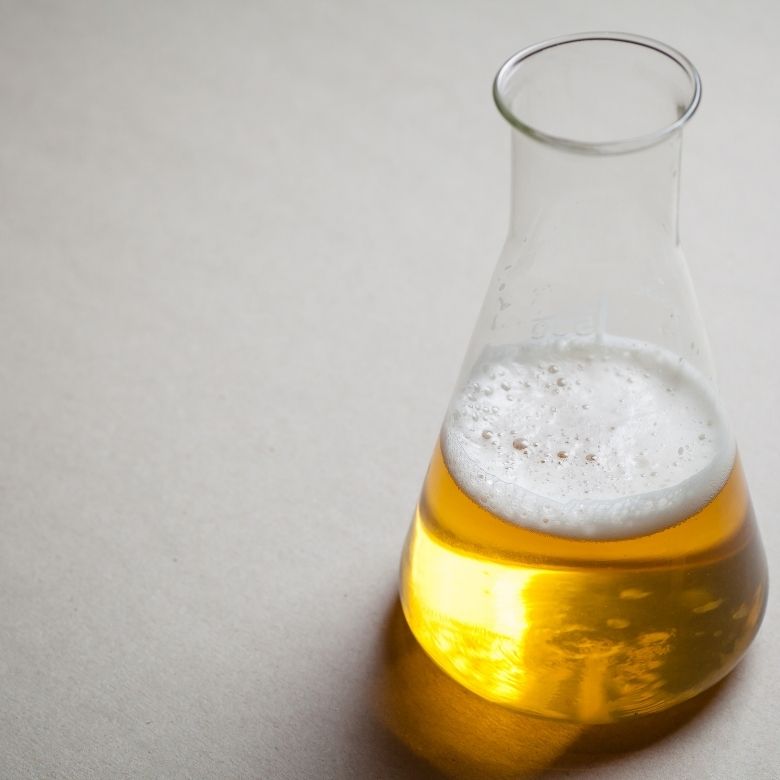Alcohols, as chemical compounds, are derivatives of hydrocarbons, in which the atom or atoms of carbon are replaced with a hydroxyl group. They may be mixed and modified for commercial and industrial applications. The most frequently used are methyl and ethyl alcohol, commonly known as methanol and ethanol. Alcohols are a very wide group of chemical compounds whose characteristic features determine their unique use.

Structure and division of alcohols
Alcohols are substances with the general formula of R-OH, where R is the hydrocarbon group and -OH is the hydroxyl group. Alcohols should not be confused with phenols (in phenols, the hydroxyl substituent is connected with the aromatic ring). Both groups have the same substituent; however, their properties are different. Alcohols are common in nature. Most people know ethyl alcohol (ethanol) as an ingredient of alcoholic drinks; however, this is only one example of this very numerous family of organic compounds. They also include substances such as cholesterol and carbohydrates. Alcohols form the so-called homologous series. This term refers to a group of organic compounds, in which every subsequent compound differs from the previous compound by a certain fixed segment. Methanol and ethanol are the first two sections of the homologous series of alcohols.
Alcohols are basically divided according to the number of hydroxyl substituents connected with the hydrocarbon group. Depending on this number, we distinguish:
- monohydroxide alcohols (mono-hydroxyl). Examples of monohydroxide alcohols are: methanol, butanol and hexanol
- polyhydroxide alcohols (polyhydroxyl), which include two or more hydroxyl groups. Among them, we distinguish, depending on the number of -OH groups, the so-called diols, triols etc. Examples of polyhydroxyl alcohols are: 1,2-ethane-diol (ethylene glycol), and propane-1,2,3-triol (glycerol).
Alcohols are also classified according to the reaction order of the carbon atom to which the hydroxyl group (-OH) is connected. Accordingly, we distinguish primary, secondary and tertiary alcohols.
Alcohol synthesis methods
There are many methods of obtaining alcohols. The synthesis itself, works related to the implementation of innovations or development of more efficient catalysts are very complex problems with processes requiring specific conditions. For industry purposes, they are most often obtained using the following reactions:
- direct hydration of alkenes
- synthesis of alkenes using the hydroxymercuration method
- synthesis of alkenes using the boron hydrogeneration method
- reaction of halogen alkanes with hydroxide ions
Methanol, ethanol and polyhydroxide alcohols, such as ethylene glycol and glycerol, are most commonly produced on an industrial scale.
Methanol was historically produced by wood distillation. Thus, the produced alcohol is called wood alcohol. At present, methanol is produced using the synthetic reaction of catalytic hydrogenation of carbon monoxide. The entire process is conducted at increased pressure, at a temperature of 300-400oC.
Ethanol is commonly produced through the alcoholic fermentation of raw materials with sugar content (plant raw materials with starch content). The substrate is transformed to proper form, which may be subjected to alcoholic fermentation. The produced mash is stripped of ethanol. The final stage is distillation, which produces distillate with 80–90% ethyl alcohol content.
Polyhydroxyl alcohols are compounds, among which the most prominent are ethylene glycol, propylene glycol and glycerin. Ethylene and propylene glycol are produced in the epoxies hydrolysis process. Glycerin is a by-product of the hydrolysis of fats and polypropylene or acrolein.

Properties
The hydroxyl group and its polarity determine the chemical and physical properties of alcohols. Like water, they form hydrogen bonds between one another in liquid form. They are responsible for aggravated liquid evaporation because particles are subject to association. This directly determines their high boiling points, for example, 78.37oC for ethanol. Methanol, ethanol and propanol may be mixed with water in any mixing ratio. However, the solubility of butanol, which is next in the homologous series, is as low as approx. 8 g/dm3. The longer the hydrocarbon chain, the lower the solubility. Most alcohols are liquids with a distinctive odor. However, alcohols with long hydrocarbon chains in particles are solids.
Are alcohols acids or alkali?
Alcohols undergo numerous chemical transformations. When we create an anhydrous environment and cause the reaction of suitable alcohol and metal, it will produce alcoholates, e.g. sodium ethylate. From a chemical perspective, they are strong chemical alkali (stronger than hydroxides).
However, from the same perspective, alcohols as a group of compounds are weak acids (weaker than H2O). This is shown by the formation of salts with metals, i.e. alcoholates.
Alkoxylated alcohols
Alkoxylated alcohols is an interesting group of (non-ionic) surfactants, produced by the synthesis of fatty alcohols that are oxyethylenated and/or propoxylated with fatty acids with different alkoxylation degrees.
The product range of the PCC Group includes 269 types of alkoxylated alcohols. Depending on the parameters, they have different features and uses, including:
- suitability for industrial uses due to washing, cleaning and laundering properties,
- capability to produce highly flexible foams with very good density and flexibility,
- usability as wetting agents in dedicated formulations for the textile and metallurgic industry,
- usability in the paper industry due to anti-foaming properties, low solidification point and easy handling.

Safety-related challenges
Although alcoholic products are versatile and useful, it may prove difficult to ensure their safe use. They are dangerous compounds that require special caution. In particular, the following aspects should be considered:
- alcohols used as raw materials, intermediate products and products should be of appropriate quality. It is prohibited to use and sell contaminated goods. This is required to ensure the safety of personnel working with them and customers purchasing the goods.
- From synthesis to dispatch to the consumer, alcohols shall be properly stored to eliminate the risk of contamination or leakage during transport. Factors like proper temperature or the proximity of other chemicals may have a significant impact on safety. Internal and external logistics in the production and sale of alcohols, as well as their mixtures, is essential for ensuring safety.
- The waste produced during the production, industrial processing or individual use shall be subject to waste disposal. It is worth contacting companies that specialize in the safe disposal of chemical waste.

Industrial use of alcohols
In industry, the most commonly used alcohols include ethanol, methanol, isopropanol and glycerin. Regardless of the sector, the use of alcohol is commonplace. In addition to the consumer use of ethanol, common uses include cleaning agents, cosmetics, fuels, pharmaceuticals, textiles and many others. They are also found in anti-freeze liquids and inks.
Alcohols are very commonly used as solvents, in particular, ethanol, which is relatively safe and may be used to solve any compounds that are insoluble in water.
Methanol is another popular solvent; however, it is predominantly used in the synthesis of other chemicals, e.g. methanal (formaldehyde), ethanoic acid or methyl esters.
Attempts are made to further expand the number of uses of alcohol-based products. The actions undertaken in Europe to reduce the use of fossil fuels encourage the use of bioalcohols as energy sources. The increased use of this type of fuel is considered inevitable. The use of alcohol distillates for energy purposes is reasonable, where the air is polluted, in particular in health resorts and areas where bans on using solid fuels, such as black coal, have been introduced. However, it should be remembered that at present the cost of generating energy or heat from alcohol-based fuels is still higher than the cost of energy from conventional fuel.
The usage of fossil fuels will be increasingly lucrative for investment and expected to increase in the near future due to the increased use of ethanol as motor fuel in the automotive industry. Ethyl alcohol generates carbon and water in combustion. It may be used alone or mixed with gasoline. The most advantageous ethanol content is 10–20%. It should be noted that the use of ethanol as fuel in the automotive industry may be advantageous for countries that do not have a petrol industry. Ethanol is successfully produced using the fermentation process. Meeting the demand of the fuel market using alcoholic products is highly probable to reduce the import of gasoline.
References:
- Bochwica, A.W.A. Preparatyka Organiczna – Vogel.pdf. 2012, 1–54.
- Maciej, M.; Żyjewska, U.; Siuda, T. Możliwości wykorzystania destylatów alkoholowych jako paliwa opałowego. Nafta-Gaz 2020, 76, 186–191, doi:10.18668/ng.2020.03.05.
- Industrial-Grade Alcohols | SolvChem Available online: https://solvchem.com/products/alcohols/ (accessed on Jan 11, 2022).
- Industrial Alcohols Market Size and Share | 2023 Available online: https://www.alliedmarketresearch.com/industrial-alcohols-market (accessed on Jan 11, 2022).
- 14.2: Alcohols – Nomenclature and Classification – Chemistry LibreTexts Available online: https://chem.libretexts.org/Bookshelves/Introductory_Chemistry/The_Basics_of_GOB_Chemistry_(Ball_et_al.)/14%3A_Organic_Compounds_of_Oxygen/14.02%3A_Alcohols_-_Nomenclature_and_Classification (accessed on Jan 11, 2022).
- Chemia organiczna by Przemysław Mastalerz (z-lib.org).pdf.
- Uses of Alcohols – Chemistry LibreTexts Available online: https://chem.libretexts.org/Bookshelves/Organic_Chemistry/Supplemental_Modules_(Organic_Chemistry)/Alcohols/Properties_of_Alcohols/Uses_of_Alcohols (accessed on Jan 12, 2022).
- Alkoxylated Alcohols – Cosmetic Ingredients | Phoenix Chemical, Inc. Available online: https://phoenix-chem.com/products/alkoxylated-alcohols/ (accessed on Jan 12, 2022).